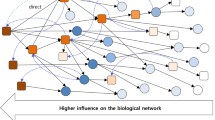Abstract
Some non-coding small RNAs, known as microRNAs (miRNAs), have been shown to play important roles in gene regulation and various biological processes. The abnormal expression of some specific miRNA genes often results in the development of cancer. In this paper, we find discriminatory miRNA patterns for cancer classification from miRNA expression profiles. The experimental results show that the expression patterns from a small set of miRNAs are very accurate in prediction. Further, the experimental results also suggest that the expression patterns of these informative miRNAs are conserved in different vertebrates during the evolution process.
Access this chapter
Tax calculation will be finalised at checkout
Purchases are for personal use only
Preview
Unable to display preview. Download preview PDF.
Similar content being viewed by others
References
Ambros, V.: The functions of animal microRNAs. Nature 431, 350–355 (2004)
Bartel, D.P.: MicroRNAs: Genomics, biogenesis, mechanism, and function. Cell. 116, 281–297 (2004)
Alvarez-Garcia, I., Miska, E.A.: MicroRNA functions in animal development and human disease. Development 132, 4653–4662 (2005)
Gregory, R.I., Shiekhattar, R.: MicroRNA Biogenesis and Cancer. Cancer Res. 65(9), 3509–3512 (2005)
He, L., Thomson, J., Hemann, M., Hernando-Monge, E., Mu, D., Goodson, S., Powers, S., Cordon-Cardo, C., Lowe, S., Hannon, G., Hammond, S.: A MicroRNA polycistron as a potential human oncogene. Nature 435, 828–833 (2005)
Lu, J., Getz, G., Miska, E.A., Alvarez-Saavedra, E., Lamb, J., Peck, D., Sweet-Cordero, A., Ebert, B.L., Mak, R.H., Ferrando, A.A., Downing, J.R., Jacks, T., Horvitz, H.R., Golub, T.R.: MicroRNA expression profiles classify human cancers. Nature 435, 834–838 (2005)
Aha, D., Kibler, D., Albert, M.: Instance-based learning algorithms. Machine Learning 6, 37–66 (1991)
Specht, D.F.: Probabilistic neural networks. Neural Networks 3, 109–118 (1990)
Zheng, Y., Kwoh, C.K.: Identifying simple discriminatory gene vectors with an information theory approach. In: Proceedings of the 4th Computational Systems Bioinformatics Conference, CSB 2005, pp. 12–23. IEEE Computer Society Press, Los Alamitos (2005)
Langley, P., Iba, W., Thompson, K.: An analysis of bayesian classifiers. In: National Conference on Artificial Intelligence, pp. 223–228 (1992)
Shannon, C., Weaver, W.: The Mathematical Theory of Communication. University of Illinois Press, Urbana (1963)
McEliece, R.: The Theory of Information and Coding: A Mathematical Framework for Communication. Encyclopedia of Mathematics and Its Applications, vol. 3. Addison-Wesley Publishing Company, Reading (1977)
Cover, T., Thomas, J.: Elements of Information Theory. John Wiley & Sons, Inc., Chichester (1991)
Cherkassky, V., Mulier, F.: Learning from Data: Concepts, Theory, and Methods. John Wiley & Sons, Inc., New York (1998)
Fayyad, U., Irani, K.: Multi-interval discretization of continuous-valued attributes for classification learning. In: Proceedings of the 13th International Joint Conference on Artificial Intelligence, IJCAI 1993, Chambery, France, pp. 1022–1027 (1993)
Frank, E., Hall, M., Trigg, L., Holmes, G., Witten, I.: Data mining in bioinformatics using Weka. Bioinformatics 20(15), 2479–2481 (2004)
Quinlan, J.: C4.5: Programs for machine learning. Morgan Kaufmann, San Francisco (1993)
Platt, J.: Fast training of support vector machines using sequential minimal optimization. In: Advances in kernel methods: support vector learning, pp. 185–208. MIT Press, Cambridge (1999)
Cohen, W.W.: Fast effective rule induction. In: Proc. 12th International Conference on Machine Learning, pp. 115–123. Morgan Kaufmann, San Francisco (1995)
Meltzer, P.S.: Cancer genomics: Small RNAs with big impacts. Nature 435, 745–746 (2005)
Author information
Authors and Affiliations
Editor information
Editors and Affiliations
Rights and permissions
Copyright information
© 2006 Springer-Verlag Berlin Heidelberg
About this paper
Cite this paper
Zheng, Y., Kwoh, C.K. (2006). Informative MicroRNA Expression Patterns for Cancer Classification. In: Li, J., Yang, Q., Tan, AH. (eds) Data Mining for Biomedical Applications. BioDM 2006. Lecture Notes in Computer Science(), vol 3916. Springer, Berlin, Heidelberg. https://doi.org/10.1007/11691730_15
Download citation
DOI: https://doi.org/10.1007/11691730_15
Publisher Name: Springer, Berlin, Heidelberg
Print ISBN: 978-3-540-33104-9
Online ISBN: 978-3-540-33105-6
eBook Packages: Computer ScienceComputer Science (R0)




